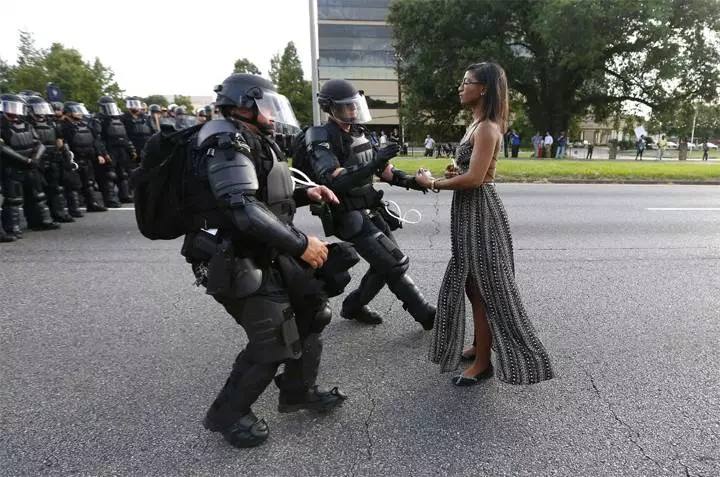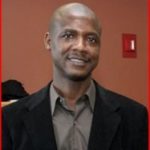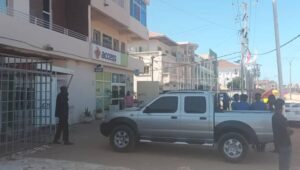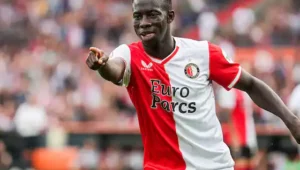
Ieshia Evans a non violent protester in Baton Rouge, U.S.A, stood calmly as police moved in to arrest her.
(Sheikh Ahmadu Bamba, founder of Muridism, Mahatma Gandhi, Martin Luther King Jr all led a nonviolent movement)
Peter Ackerman and Jack Duval in their book, ‘A Force More Powerful’ refer to the nonviolence movement of the 20th Century as “a tale of ten decades, of popular movements battling entrenched regimes or military forces with weapons very different from guns and bullets.” They go on to say, “Protests such as petitions, parades, walkouts, and demonstrations were used to rouse public support for movements.”
Forms of non-cooperation such as strikes, boycotts, resignations, and civil disobedience helped subvert the operations of governments. And direct intervention such as sit-ins, nonviolent sabotage, and blockades frustrated many rulers’ will to subjugate their people.’
Gene Sharp argues that “by combining non-violent discipline and persistence in struggle, the nonviolent actionists cause the violence of the opponent’s repression to be exposed in the worst possible light.” While from the impressive record the efficacy of nonviolence in challenging power cannot be doubted, a question arises as to its applicability in a country like the Gambia in a society like ours where violence is the order of the day, not only from the state on citizens, but among the citizens themselves and where widespread poverty thwarts every effort of the majority to live a life of dignity.
The answer to this question lies in reminding ourselves that the very real and seemingly intractable problems that afflict our society – from ethnic clashes to domestic violence to police brutality – can be traced, to use the words of Leonardo Boff, to “entrenched structural violence that has its roots in the elite institutions of power in a social structure that protects the interests of the dominant groups… which will not tolerate any social change out of fear of losing their privileged status.”
It was early morning of April of the year 2016. It had been a year of heightened activity on the political scene as civil and political rights activists campaigned for electoral reform. President Yahya Jammeh had adopted a programme of mass action to force his lieutenants continued to stand menacingly in the way of reforms. Solo Sandeng had held a protest without a permit at Westfield Junction in early April, but had been violently dispersed with teargas before they could get arrested and detained near at the premises of the then notorious National Intelligence Agency.
Now, Solo Sandeng with pro-democracy activists predictably, this protest too had been outlawed and by the time morning dawned, the Westfield Junction was surrounded by forces of tyranny armed to the teeth and dressed in jungle fatigues.
To the surprise of many, despite the heavy presence of both regular and Para-military police surrounding Westfield Junction, the protesters did manage to get into the circle that fateful morning, a few hundred of them before the police regrouped to seal off the breach in the fence that identified as entry point before. Once inside the circle, Solo Sandeng the leader of the group went ahead trying to organize the people to protest.
The police quickly surrounded the group and use force to disperse the demonstrators. There was police brutality. Unfortunately, Solo and pro-democracy activists face a barrage of menacing armed policemen, right versus might.
Pro-democracy activism before armed policemen was not a common response in demonstrations in support of democracy in the Gambia. Indeed, many would consider the act foolhardy. And yet it was part of a long tradition of responding to injustice and oppression, especially against a much stronger opponent. It is called nonviolent action.
For centuries and generations, human beings have been conditioned to believe that there are only two possible ways to react to evil, injustice or oppression – fight or flight. Many of us, those in the flight category, accept injustice passively and avoid conflict, refusing to resist evil under the pretext of ‘turning the other cheek.’ Others, those in the ‘fight’ category choose to take up arms in violent rebellion against oppression.
However, passivity in the face of injustice implicates us in perpetuating the injustice while using force to retaliate against it sucks us into the cycle of violence and makes us perpetrators of new forms of injustice. This leaves nonviolent action as the most effective weapon an oppressed people can deploy against their oppressors.
Nonviolence is a philosophy and strategy for social change that rejects the use of violence. As such, nonviolence is an alternative to passive acceptance of oppression and armed struggle against it. Various forms of nonviolence have been deployed over the ages to effect peaceful social change, especially during the last century. It has come to be associated with Sheikh Ahmadu Bamba, founder of the Muridism Sect, Mahatma Gandhi, who led a nonviolent movement for India’s independence and Martin Luther King Jr who led the Civil Rights Movement in the American South in the 1950s and 1960s.
The two moral icons of the 20th Century were followed in the footsteps of another moral icon that lived in First Century Palestine, Jesus of Nazareth. Jesus taught his followers to love their enemies and not to render evil for evil. ‘Turn the other cheek’ one of his more famous sayings has sometimes been misinterpreted to mean that Jesus counselled submission to oppression and injustice. But he did no such thing. Read in its proper context, Jesus’ admonition not to resist evil was an admonition not to use evil using violent means or insurrection in resisting evil. But he fully expected injustice and oppression to be resisted through finding a creative alternative to violence and in a way that asserted the victim’s own humanity and dignity.
Like Sheikh Ahmadu Bamba, Gandhi and King after him, Jesus practiced a deeply spiritual form of nonviolence that sought not only to resist evil, but ultimately to convert the opponent. As one writer says, “If through love for your enemy you can create in him respect and admiration for you, this provides the best possible means by which your new idea or suggestion to him becomes an auto-suggestion within him, and it will also help nourish that auto-suggestion.”
Both Sheikh Ahmadu Bamba and Gandhian nonviolence, based on the spiritual notion of or soul force assumes that the activist has something to learn from his/her opponent and vice versa and that truth can never be achieved or disseminated by force. King’s nonviolence was a fusion of Jesus’ philosophy and Gandhi’s methods which he applied to great effect to lead the civil rights movement in the South of the USA
Martin Luther King’s most pivotal moment would seem to be the clear August day in 1963 when he mounted the rostrum of the Lincoln Memorial to deliver his famous ‘I have a Dream’ speech in which he spoke in prophetic tones of the kind of America he hoped his and others’ nonviolent actions would help to build.
Like Gandhi before him, King used a ‘step-wise’ approach to prepare for and engage in nonviolence campaign against a particular issue. This approach consisted of information gathering, education, personal commitment, negotiations, direct action and reconciliation, in that order.
Before and since Gandhi and King, nonviolence has been used to challenge authoritarian power and effect social change in innumerable situations from Orthodox priest, Georgii Capon, persuading 150,000 workers to walk the icy streets of Russia’s ancient capital in the 20th Century’s first public challenge to autocratic power, to bringing down dictatorships in the Philippines to ending communism in Eastern Europe and hastening the end of apartheid in South Africa.
In our efforts to extricate ourselves from this web of structural violence, nonviolence action is our only real option for this Third Way enables those who are few in number or poor in material resources to stand up for their rights with moral strength and dignity.
By Alagi Yorro Jallow











Recent Comments